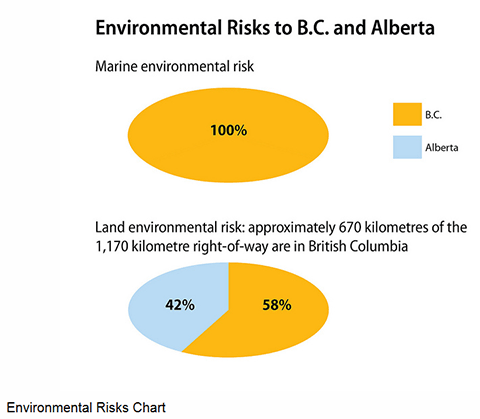|
| |
| 30. Juli 2012 |
Heftiger Streit zwischen BC und Alberta
über das Northern Gateway Pipeline-Projekt |
| |
| Zwischen den beiden Premierministerinnen von BC und Alberta, Christy Clark und Alison Redford, ist ein heftiger Streit entbrannt über das Northern Gateway Pipeline-Projekt der Enbridge Inc. Hierbei geht es Christy Clark weniger um den Schutz der Umwelt vor einer mit extrem hoher Wahrscheinlichkeit zu erwartenden Ölkatastrophe in BC, sondern viel mehr um Geld, um Petro-Dollars. Von den aus dem Pipeline-Projekt zu erwartenden Steuereinnahmen will sie für BC einen wesentlich höheren Anteil als vorgesehen ergattern. Aus dem Betrieb der Northern Gateway Pipeline – sofern sie gebaut werden sollte – erwartet der Kanadische Staat Steuereinnahmen von 81 Milliarden CAD. 36 Milliarden würden an die kanadische Regierung fließen, 32 Milliarden an Alberta und nur 6,7 Milliarden an BC. Terry Lake, Minister of Environment von BC erklärte: „Analysis … indicates only about 8 per cent of incremental fiscal benefits comes to British Columbia. And yet, 100 per cent of the marine risk and 58 per cent of the land-based risk sits with British Columbia.“ In dem schon als „Krieg der Worte“ bezeichneten Streit mit Redford forderte Christy Clark: „My basic request is for Alberta and Canada to come to the table and sit down with British Columbia and work to figure out how we can resolve this … If that’s going to cause such a big problem that there are trade barriers, there is a very easy way to solve that – no pipeline.“ Alison Redford hat die Abtretung von Steuereinkünften an BC strikt abgelehnt. Christy Clark entgegnete ihr öffentlich: „If Alberta doesn’t sit down and talk about it, the project can’t go ahead. It’s as simple as that.“ |
| |
 |
| Erwartete Einkünfte aus dem Northern Gateway Pipeline-Projekt für British Columbia und Alberta |
| © Government of British Columbia |
| |
 |
| Die Verteilung der Umweltrisiken des Northern Gateway Pipeline-Projektes auf British Columbia und Alberta |
| © Government of British Columbia |
| |
| Nachdem Clark das vernichtende Urteil des US National Transportation Safety Board (NTSB) zum Verhalten des Enbridge-Konzerns bei der Ölpest im Kalamazoo River in Michigan vorgelegt bekam, meinte sie zu Enbridge: „If they think they’re going to operate like that in British Columbia, forget it.“ Clark nannte das Verhalten der Enbridge Corp. „schändlich“ (disgraceful). Clark nannte fünf Bedingungen, unter denen die Provinzregierung von BC jedoch dem Pipeline-Projekt zustimmen würde: Eine höhere Beteiligung an den zu erwartenden Steuereinnahmen, die Zustimmung der First Nations zu diesem Projekt und deren Beteiligung hieran, die Zustimmung bzw. Empfehlung des Joint Review Panel zum Bau der Pipeline und „Weltklasse-Standards“, um eine Ölpest sowohl an Land als auch im Wasser vermeiden und gegebenenfalls bekämpfen zu können. Clark verweist auf strenge Sicherheitsvorschriften beim Transport von Öl und zitiert als Vorbild Norwegen, wohl wissend, dass in norwegischen Pipelines herkömmliches Rohöl transportiert wird und nicht das extrem umweltschädliche Öl aus den Teersanden in Alberta. Sie gibt sich darüber hinaus der naiven Illusion hin, dass eine Ölpest zu Wasser oder an Land effektiv und rasch bekämpft werden kann. In einer Presseerklärung des Umweltministeriums von BC vom 23. Juli (Ministry of Environment, British Columbia outlines requirements for heavy oil pipeline consideration. Updated July 24, 2012 – to add link to Technical Analysis) werden die fünf Bedingungen der Provinzregierung für die Zustimmung zum Pipelinebau präzisiert: |
| „As part of ongoing work to participate in and monitor the Joint Review Panel on the Northern Gateway Project, the government of British Columbia today outlined five minimum requirements that must be met for the province to consider the construction and operation of heavy oil pipelines within its borders. … |
| As set out in our government’s heavy oil policy paper, Requirements for British Columbia to Consider Support for Heavy Oil Pipelines, the following requirements must be established: |
- Successful completion of the environmental review process. In the case of Enbridge, that would mean a recommendation by the National Energy Board Joint Review Panel that the project proceed;
- World-leading marine oil spill response, prevention and recovery systems for B.C.’s coastline and ocean to manage and mitigate the risks and costs of heavy oil pipelines and shipments;
- World-leading practices for land oil spill prevention, response and recovery systems to manage and mitigate the risks and costs of heavy oil pipelines;
- Legal requirements regarding Aboriginal and treaty rights are addressed, and First Nations are provided with the opportunities, information and resources necessary to participate in and benefit from a heavy-oil project; and
- British Columbia receives a fair share of the fiscal and economic benefits of a proposed heavy oil project that reflects the level, degree and nature of the risk borne by the province, the environment and taxpayers.
|
| … Led by B.C.’s Minister of the Environment, work has now been completed to assess what would be required to establish British Columbia and Canada as world leaders in marine oil spill response. British Columbia is proposing a joint plan of action with the federal government that would include the following elements: |
- Limits to liability that ensure sufficient financial resources to properly address any spills;
- Increased federal response capacity;
- Full adoption of the Unified Command model;
- Strengthened federal requirements on industry for the provision and placement of marine response equipment and infrastructure;
- Industry-funded terrestrial (land-based) spill co-operative with sufficient human and technical capacity to manage spill risk from pipelines and other land-based sources;
- Increased capacity within the provincial emergency response program to ensure adequate oversight of industry; and
- A Natural Resources Damage Assessment process to provide certainty that a responsible party will address all costs associated with a spill.“
|
| Für Peter Robinson von der David Suzuki Foundation zeigte sich angesichts dieser Pressemeldung, dass auch die Provinzregierung von BC eine Ölpest bei der Realisierung des Northern Gateway Projektes als „unvermeidlich“ erachtet. Judith Lavoie schrieb im Times Colonist vom 24. Juli (Foes don’t see way to keep coast safe if tankers spill): „Environmental groups are dismissing as meaningless the B.C. government’s announcement of conditions that must be met before the Enbridge Northern Gateway pipeline gets the go-ahead. There is no way that government can be given any hard guarantees that B.C.’s fragile northern coastlines will not be soiled by an oil spill as tankers take bitumen from Kitimat to Asian markets through rough seas and narrow inlets, the Raincoast Conservation Foundation said. Requirements for a world-leading marine oil spill response, prevention and recovery system for the B.C. coastline cannot be met, said Paul Paquet, Raincoast senior scientist. ‚The federal government announced the closure of B.C.’s command centre for emergency oil spills earlier this year, and neither the coast guard nor Transport Canada have the capacity to deal with a catastrophic oil spill‘, he said. ‚Has there ever been a successful cleanup from a massive tanker spill?‘ asked Raincoast conservation biologist Misty MacDuffee. ‚Oil spill technology only works in ideal conditions with no wind and waves.‘ One problem is that the behaviour of diluted bitumen, once spilled in the ocean, is a complete unknown, MacDuffee said. Once it dissipates, it is likely the oil will sink or float submerged below the surface, she said.“ |
| Die Living Oceans Society (LOS) verurteilte ebenfalls die Haltung der Provinzregierung zum Northern Gateway Pipeline-Projekt. In einer Erklärung der LOS heißt es: „‚World-leading marine oil spill response and recovery systems will do nothing for us in the event of a spill of tarsands bitumen‘, said Karen Wristen, Living Oceans’ Executive Director. ‚First, Enbridge needs to establish to the satisfaction of British Columbians that there exists any technology that could clean up such a spill. When diluted bitumen is spilled into water, much of it sinks to the bottom where conventional spill response technology is simply useless.‘ Diluted bitumen, or dilbit, contains a much higher proportion of heavy asphaltenes and resins than conventional oil. These components do not float on water and are highly resistant to dispersant chemicals. ‚The rest of the components of dilbit may float for some time, giving off a toxic cloud of benzene, toluene and hydrogen sulphide that would make oil spill response hazardous‘, Wristen said. ‚By the time people could actually get close enough to deploy any kind of surface-cleaning technology, any oil remaining on the surface would be widely dispersed by the action of currents, wind and waves.‘ Once the heavier components of the dilbit sink to the ocean floor, it is unknown how long they will persist. The bacteria that degrade conventional oils live on the surface of the water. It is expected that the tar-like goo would smother life on the ocean floor wherever it lands. ‚The Kalamazoo River spill in July, 2010 gave us clear evidence that the transportation of dilbit is a dangerous experiment that we don’t know how to control‘, said Wristen. ‚If a spill were to happen in sensitive near-shore environments, such as the Douglas Channel route into Kitimat, it would impact the entire local ecosystem for decades, perhaps centuries, to come.‘“ |
| |
 zurück zurück |
|
|

